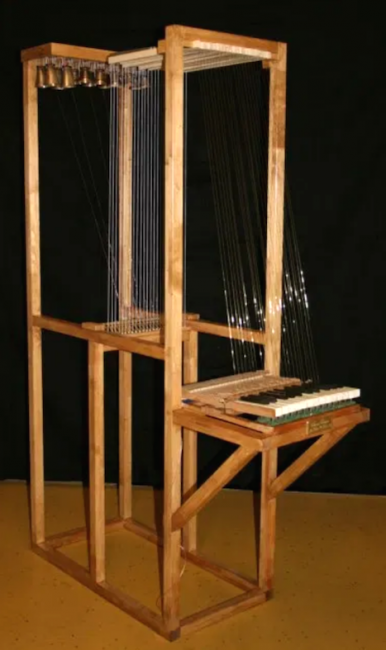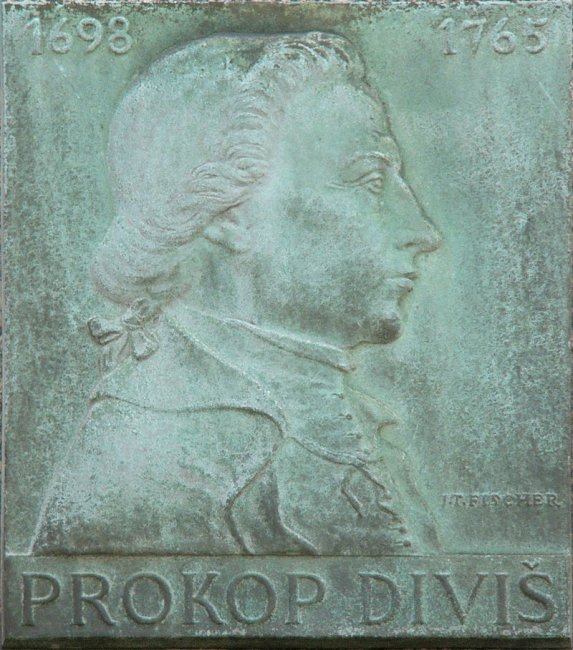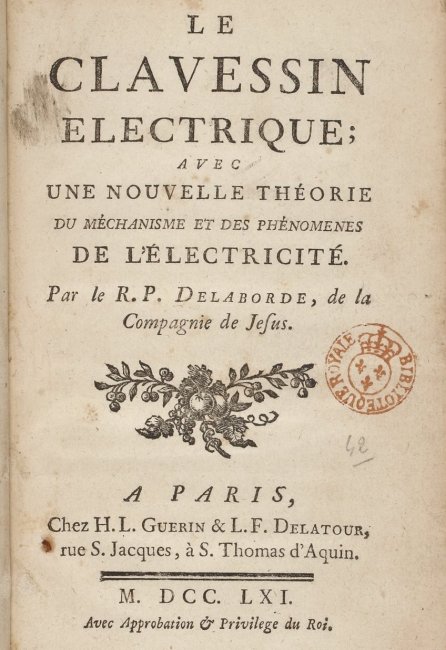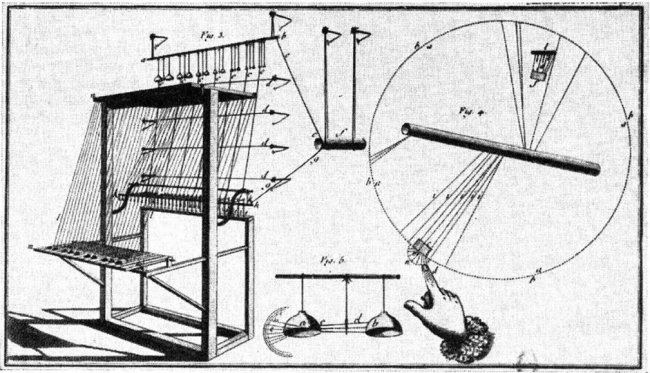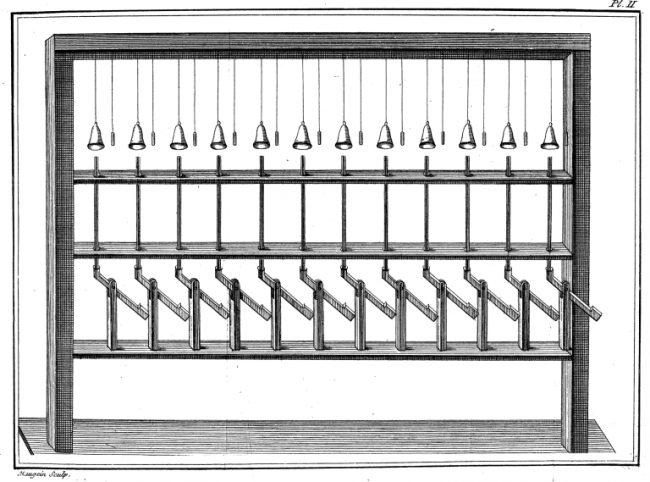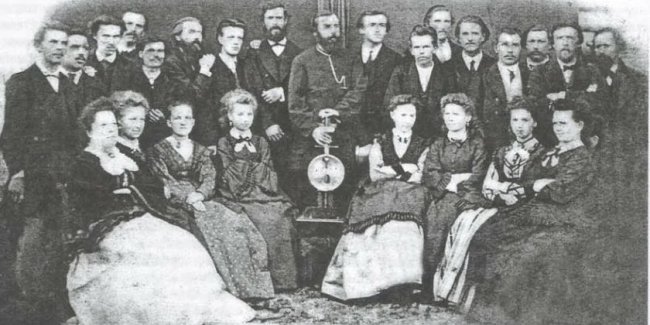The first electric musical instruments: Prokop Divisha's denidore, de Laborde's electric harpsichord, Polenov's melodrama
We do not know who or when first came up with the idea of using electricity for musical purposes. We do not know who was the author of the first electromusical construction. It is only known that as soon as scientists and engineers got hold of a new type of energy — electricity, they began to think about possible ways of using it: in technology, in scientific research, in art.
Today it is impossible to imagine a musical life without an electric guitar, an electric organ, an electronic synthesizer, and the combination of the words electricity and music has long become natural and familiar, but it was not always so.
An electric harpsichord in the National Library of France in Paris — considered the world's first power instrument
The world's first electronic instrument - from 1753.
The Czech inventor, clergyman and musician Prokop Divis (1698 - 1765) is called the European Franklin.The main work of his life was devoted to the study of atmospheric electricity.
Prokop Divish was born in 1698 in the village. Therefore, Helvikovice near Amberk, not far from Hradec Kralove in the Korvej family (fortress), was at the lowest level of social origin. At the age of 18, he entered a monastery, and in 1726 he was ordained a priest. Procopius is his monastic name.
After ordination to the priesthood, he taught philosophy at the monastery school in Lowe. Three years later he became professor of philosophy; he differs from his predecessors mainly in that he accompanies his physics lectures with a demonstration of various experiments.
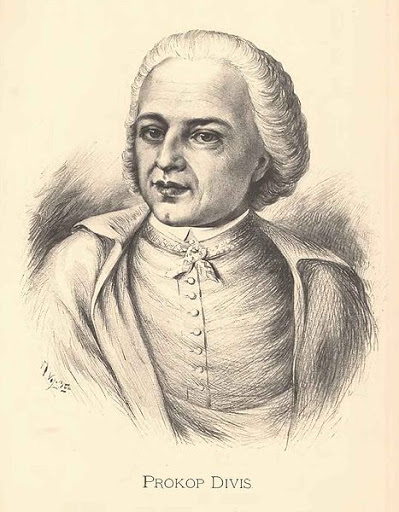
Most of all, Prokop Divish is known for the fact that in 1754 he built the first lightning rod in Europe, designed by him, apparently completely independently of B. Franklin (cf. The history of the creation of a lightning rod).
Divish foresees the practical importance of electricity and tries to find a way to use it for the benefit of people. He turned to medicine and started electrotherapy. At home, he created a free clinic, treated (and, as contemporaries of the scientist claim, not without success) people suffering from rheumatic pains.
The works of a researcher from the small Moravian town of Pšimetice brought their author European fame. He corresponded with the greatest scientists of his time.
Divish also became famous for his original musical instrument called «denidore». The first notice of this instrument is dated February 27, 1753, and is contained in a letter from the evangelical theologian Ettinger to Divisch, which is a reply to an unknown letter from Divisch to this priest of the town of Württemberg Weinsberg. Therefore, work on the instrument was completed in early 1753.
The electric musical instrument Denis d'or, designed by Divis, also called "Zlaty Divis" in Czech, which means "golden Dionysus" in French, was distinguished by its beauty and variety of sounds.
The Denidor was a 160 cm long, 92 cm wide and 128 cm high box-type jet instrument with a pedal and a protruding keyboard.
All its parts were held together by rotating bolts. It had 790 metal strings, 14 mostly double registers, and when played the first register sounded full, the second muted, with a long resonance.
The mechanics of the instrument are ingenious, but also simple. It sets up quickly and easily (in 45 minutes). The sounds of harp, lute, piano, bells, horn (french horn), bassoon and clarinet can be derived from it. By electrifying the strings, he achieved a fuller and cleaner sound.
The electric friction machine that Divish made himself and called it «electrum». He learned how to grind glass and make hollow glass balls with a diameter of 20 cm. On them he put smooth iron circles - collectors. A feature of the device was a friction cushion—a wooden board covered with calfskin.
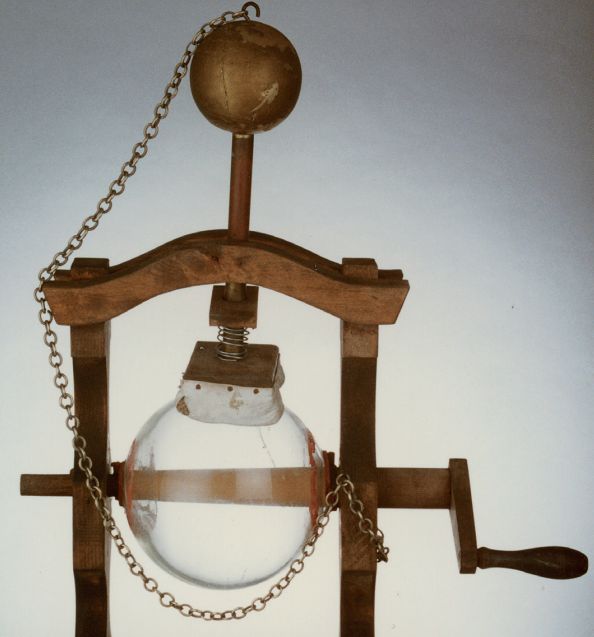
Electric friction machine for electrifying bodies from Prokop Divis
He received an electric charge in this way: with one hand with a handle, he rotated a glass ball, and with the other in a leather glove, he applied his palm to its surface. When he felt an electric charge on the surface, he activated the pad.
Electric charge was deflected by means of an iron circuit in a Leyden jar, and originally a plate of copper tin served as a capacitor, the edges of which were insulated with wax.
The Leiden bank Divisha was a cylindrical glass vessel 32 cm high and about 4 liters in volume.The diameter of the upper part of the cylinder is 13.2 cm, and the diameter of the lower part is 11 cm. A rod passes through the center of the cylinder, it is twisted in a spiral at the bottom, and its upper part protrudes 11.5 cm from the edge of the cylinder.
The lower part of the box cylinder is filled with compacted iron filings filled with rosin, the upper circuit is connected to an electric friction machine.
If we take into account the fact of electrification of the strings of "Denidor", then we can establish that Divish was experimenting with electricity when this musical instrument was already made. It is possible that his long-standing interest in music led Davis through the "denidore" to experiments with electricity.
It is known that Prokop Divish learned to play his instrument perfectly and taught this art to several organists.
The information about the "denidora" reached the Prussian Prince Henry, he wanted to buy an instrument. But this was prevented by the death of Divish. As he himself wrote in 1762, Divish was working on the creation of the second "Denidor".
Memorial plaque to Prokop Divis by Jan Tomasz Fischer (1912 — 1957) in the former Jesuit high school on the Jesuit Square in Znojmo
After the death of Divis, «Denidor» ends up in Luoka Abbey, where they know how to play it. With the closure of the monastery in 1784, the "golden wild" was transported to Vienna and was kept unused in the imperial palace for a long time.
Finally, the former organist of Luoka Cathedral, Norbert Wieser, appeared in Vienna. He had a good command of the instrument and often played it, participating in palace concerts. As a reward for his prowess, Emperor Joseph II presented Viser with a denidor.
Then he became its owner, traveled with it in Austria-Hungary and earned good money playing it.Recently Wieser gave concerts in Prešpurk (now Bratislava), where traces of Denidore and his master are lost. Since then, the fate of "Denidor" is unknown.
Electric harpsichord
One of the scientists whose names are associated with the creation of the first electric musical instruments is the Frenchman Jean-Baptiste de Laborde (Delabord, Jean-Baptiste Thieu Delaborde) (1730-1777), who has deep and extensive knowledge in the fields of mathematics and physics for his time.
At that time, the scientific world of France, like other European countries, was fascinated by the study of electricity. Jean-Baptiste de Laborde dreamed of creating a theory to explain electrical phenomena.
To this end he subordinated all his experiments, including work on the construction of an unusual harpsichord, acting with the help of electrostatic forces. The design of the instrument was described by de Laborde in his main work of 1759: "An electric harpsichord with a new theory of the mechanism and the phenomenon of electricity'.
The construction of the harpsichord was based on bells hung in a row. Each pair of bells with a hammer hanging between them had a specific pitch. An electric charge obtained by friction was applied to the bells.
Pressing the corresponding key grounded one of the bells and disconnected it from the charge source. So the hammer moved, attracted by the charged bell, struck it, charged, then struck the second bell, giving it a charge, and so on until the key was pressed. The sound effect was enhanced by the use of organ pipes.
According to de Laborde, his instrument can be played like an ordinary harpsichord or organ. The instrument made a special impression in the dark — sparks poured out of it like colorful fireworks.
Many people came to de Laborde to hear the unusual sound of the harpsichord. The press published favorable and even enthusiastic reviews of the invention.
Not without detractors, however. De Labor was accused of borrowing the idea for the design from Louis-Bertrand Castel, who had died shortly before this time, a scholar who had devoted thirty years of his life to the study of color music. Whether Castel actually had the idea of using electricity to create musical instruments is unknown, in any case he did not actually implement anything of the sort.
So, more than two hundred years ago, when the science of electricity was just taking its first timid steps, music lovers had the opportunity to enjoy the unusual sound of instruments from the distant future.
Magnetic harpsichord
The Clavecin Magnetique was one of the first acoustic instruments to use magnetic attraction. This instrument was the result of an experimental investigation into the nature of magnetism and electricity—very modern at the time—by Abbé Berthollon de Saint-Lazare (1741-1800), a Jesuit priest, mathematician, and naturalist from Montpellier in France.
Abbot Bertolona's magnetic harpsichord - around 1780
Bertollon's invention was a simple instrument that produced sounds using metal bells to strike tuned bells, raising and lowering magnets controlled by a keyboard.
Bertolon wrote and published numerous books on the phenomena of electricity and magnetism and their potential medical applications.
In Magnetique Du Clavecin (Paris, 1789), Bertolon referred to and praised two other keyboard instruments that influenced his design—Jean-Baptiste de Laborde's Electric Harpsichord (France, 1759) and Louis Bertrand Castel's Color Organ (Paris, France, 1725)
Engineer Polenov's musical instrument
Many scientists who highly appreciated the work of the outstanding Russian metallurgist Konstantin Polenov (1835 — 1908) only shrugged their shoulders disapprovingly when they learned that the researcher was seriously engaged in some "melodrom".
K. P. Polenov was in charge of the mining plant at Nizhnesalda in the Urals, where he introduced many remarkable improvements. The scientist also works on the practical application of electricity.
It is possible that the role of K. P. Polenov in the study of electricity was underestimated. So, there was an assumption that even before Yablochkov he invented electric lighting, and in the office of Saldinskaya in the Perm province, back in the seventies, an electric lantern was lit in the evening - then they were not in any of the European cities. This was mentioned in a pamphlet dedicated to the memory of Polenov, published in 1908.
From the same pamphlet we learn that "K.P. Polenov on the application of electricity to musical instruments and the device he invented for melodrama enables anyone, with the help of special notes, to play harmony without prior training." The melodium was a favorite invention of Konstantin Pavlovich, and he did not stop improving it until the end of his life. «
However, Polenov's "melody" - this kind of electric harmonium of the 19th century, a device about which, by the way, we know almost nothing, except for fleeting archival references, remained for the scientist's contemporaries nothing more than entertainment, curiosity. Just as the "denidore" of the Czech scientist Prokop Divis once was.
Unlike the legendary Divisch invention, which has come down to us only in descriptions from old documents, a working model of de Laborde's 1759 electric harpsichord is in the National Library of France in Paris. Maybe that's why de Laborde's electric harpsichord is considered the first electric musical instrument in history.

